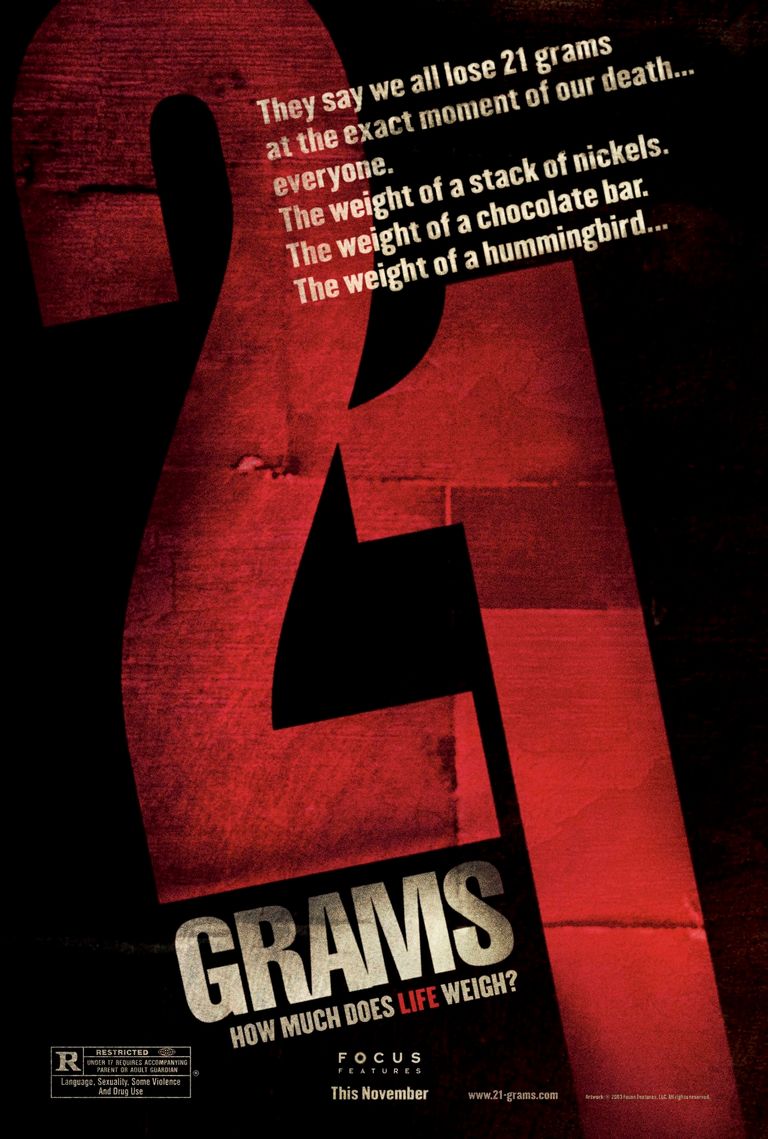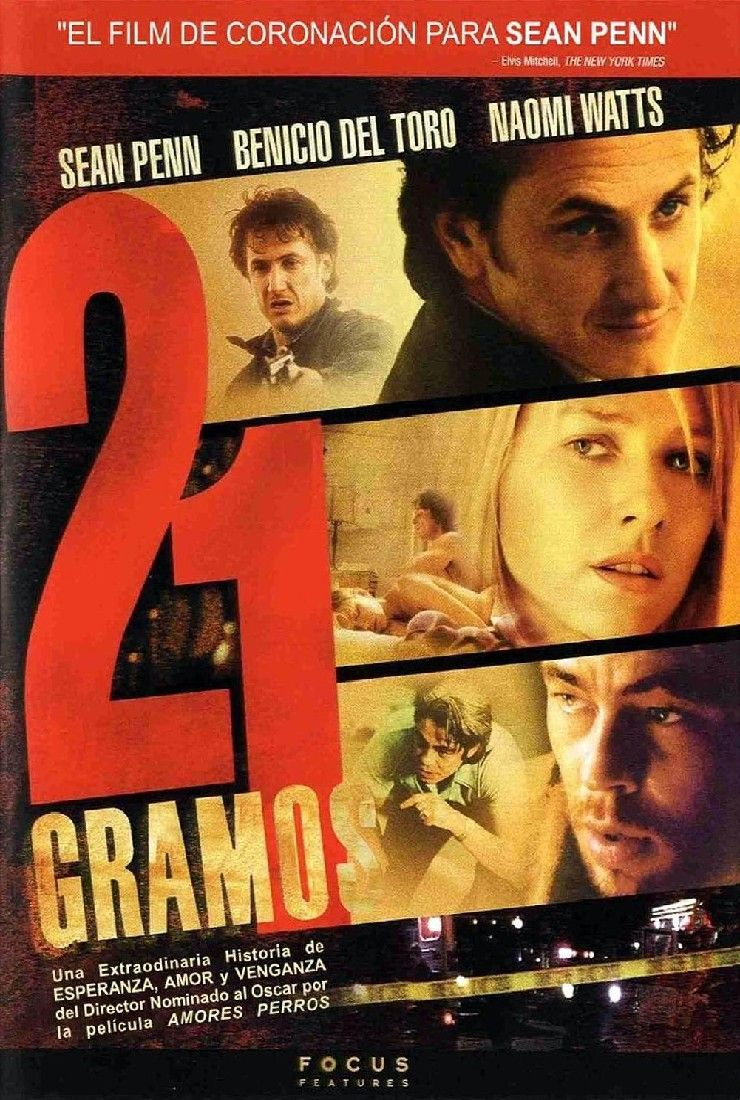
21 Grams is the second film of the so-called Death Trilogy
21 Grams is a 2003 film directed by Alejandro González Iñárritu. It is the second film of the so-called Death Trilogy by the Mexican director; the same trilogy also includes Amores perros and Babel.
The title of the film refers to the hypothetical weight (precisely 21 grams) that anyone would lose upon exhaling their last breath, calculated by Dr. Duncan MacDougall.
It was released in theaters in the United States on November 21, 2003, and on January 16, 2004 in Italy.

21 Gramos es una película de 2003 dirigida por Alejandro González Iñárritu. Se trata de la segunda película de la llamada Trilogía sobre la muerte del director mexicano; Amores perros y Babel también forman parte de ella.
El título de la película hace referencia al peso hipotético (21 gramos) que cualquier persona perdería al dar su último aliento, según calculó el doctor Duncan MacDougall.
Se estrenó en cines en Estados Unidos el 21 de noviembre de 2003 y en Italia el 16 de enero de 2004.

Jack Jordan is a former prisoner who became a fundamentalist believer following his last period of detention. His family life is made difficult by his insistence on faith, which often leads to fanaticism, while his chances of finding work are compromised by his unfortunate fame.
Cristina is a former cocaine addict who now lives a quiet life with her husband and two daughters.
Paul Rivers is a mathematician with serious heart problems and is looking for a donor; due to his infirmity he finds himself living with his ex-wife Mary again, who wants to have a child with him at all costs, even by resorting to artificial insemination.
The pivotal event, around which the whole story revolves, is the car accident in which Jack Jordan runs over Cristina's husband and daughters, who die due to failure to provide assistance. Michael's heart (Cristina's husband) is thus implanted in Paul Rivers, who can finally return to his life, but is obsessed with finding the person to whom he owes his life.
He will thus arrive on the trail of Cristina (who has returned to being addicted to various substances and alcohol) establishing a relationship with her that at first seemed compromised by the sad bond that united them. The two decide to kill Jack Jordan (who had turned himself in and had already served his sentence) to make him pay, and they move into the same motel where he now lives. This will lead to the final meeting between the three now exhausted characters and the dramatic conclusion of the story.
The film - the second work by Mexican director Alejandro González Iñárritu after Amores Perros and the first film by the same director shot in the USA - is a psychological drama with a narrative structure and a shooting technique that constitute its peculiar characteristics: the first part of the film is made up of continuous flash-forwards while some of the shots are performed using cameras without a tripod that tend to give the images a particular effect.

Jack Jordan es un ex convicto que se convirtió en un creyente fundamentalista después de su última estancia en prisión. Su vida familiar se ve dificultada por su insistencia en la fe, que a menudo conduce al fanatismo, mientras que sus posibilidades de encontrar trabajo se ven comprometidas por su desafortunada reputación.
Cristina es una ex adicta a la cocaína que ahora lleva una existencia tranquila con su marido y sus dos hijas.
Paul Rivers es un matemático con graves problemas cardíacos y busca un donante; Debido a su enfermedad se encuentra viviendo nuevamente con su ex esposa Mary, quien desea tener un hijo con él a toda costa, incluso recurriendo a la inseminación artificial.
El acontecimiento central en torno al cual gira toda la historia es el accidente de coche en el que Jack Jordan atropella al marido y a las hijas de Cristina, quienes mueren por falta de auxilio. El corazón de Michael (el marido de Cristina) queda así implantado en Paul Rivers, quien por fin puede volver a su vida, pero está obsesionado con encontrar a la persona a la que le debe la vida.
Se cruzará así con el rastro de Cristina (que ha vuelto a ser adicta a diversas sustancias y al alcohol) estableciendo con ella una relación que al principio parecía comprometida por el triste vínculo que los unía. Los dos deciden matar a Jack Jordan (que se había entregado y ya había cumplido su condena) para hacerle pagar, y se mudan al mismo motel donde ahora vive. Esto conducirá al encuentro final entre los tres personajes ahora agotados y a la dramática conclusión de la historia.
La película –la segunda obra del director mexicano Alejandro González Iñárritu después de Amores perros y la primera película rodada en Estados Unidos– es un drama psicológico con una estructura narrativa y una técnica de filmación que constituyen sus características peculiares: la primera parte de la película consta de a partir de continuos flash-forwards mientras que algunas de las tomas están hechas con cámaras sin trípode, lo que tiende a dar a las imágenes un efecto particular.

Sean Penn: Paul Rivers
Naomi Watts: Cristina Peck
Benicio Del Toro: Jack Jordan
Charlotte Gainsbourg: Mary
Danny Huston: Michael
Eddie Marsan: John
Melissa Leo: Marianne
John Rubinstein: ginecologo
Clea DuVall: Claudia
Denis O'Hare: Dr. Rothberg
Marc Musso: Freddy
Paul Calderon: Brown Paul Calderón: Brown

Just as Sean Penn's organ is dissected in the surgery, so is the story itself; the heart is the cocoon that envelops the narrative, from which the entire triad would like to free themselves. Paul can't, forced into a wheelchair; he won't be able to do it even afterwards, locked in the cyanotic pressure cooker of the organism (the retching). Cristina is also a hostage of the heart: it is what separates her from her husband and the two little girls, three corpses behind a bend imprinted only on the answering machine.
And then the heart of Jesus - or rather, of Jesus: Jack (yes) draws a very personal god, who stamps his feet from the iconography on the wall and loves very, very much, too much, to the point of disturbed fanaticism (the family dinner). He preaches to turn the other cheek but omits help, while the sound of the parishioners' songs varies in his ears: the joyful hymn to the Lord that in reality is a shady soundtrack of decay. Moving lightly like shadows (or perhaps: heavy as 21 grams), the lines of the story are accompanied by a light concentric buzz: the scream of a lawnmower gone mad in the meadow, but above all the rewind of the circle of time.
This extends, rolls up, suffers with the protagonists, is silent agnostic (the very first scene), bursts with noise (the accident) and finally deceptively finds its outlet: it seems that with the scalpel you can start again, but it is always him - the heart - "the culprit".
The triptych of souls lowers their heads in cruel/tender acceptance, but no one embraces their own catharsis (Paul waits for another heart, Cristina remembers his daughters, Jack returns locked in the house of fundamentalism).
The entire film is hurled with the slingshot of an overused metaphor; the Spanish works by subtraction, let's do it too. Let’s remove the elegantly gratuitous autopsy of the image, let’s remove the three main actors (Benicio always splendid and altered), let’s remove the directorial passages (the slow motion of the main scene): there remains the Indian file of topoi (stereotypes?) – accident, mourning, love, revenge, hospital, death-, some catchy phrases that mean little or nothing (the one that justifies the title), a film that shows the peacock’s tail. Inarritu closes a desperate work but he is fine and it shows, with his own detachment he distances us from the narrative by showing the last organ in formaldehyde: his heart, just a glance and away, regular beat.

A medida que el órgano de Sean Penn es disecado durante la cirugía, también lo es la historia misma; El corazón es el capullo que envuelve la narración, del que toda la tríada querría liberarse. Paul no puede, está confinado a una silla de ruedas; No podrá hacerlo ni siquiera después, encerrado en la olla a presión cianótica del organismo (las arcadas).
Cristina también es rehén de su corazón: es lo que la separa de su marido y de sus dos pequeñas niñas, tres cadáveres detrás de una curva de la carretera registrada sólo en el contestador automático. Y luego el corazón de Jesús –o mejor dicho, de Jesús: Jack (sí) dibuja un dios muy personal, que patea el suelo con la iconografía de la pared y ama mucho, mucho, demasiado, hasta el fanatismo perturbado la cena familiar).
Predica la oferta de poner la otra mejilla pero omite la ayuda, mientras en sus oídos varía el sonido de los cánticos de los feligreses: el alegre himno al Señor que en realidad es la sombría banda sonora de la decadencia. Moviéndose tan ligeras como sombras (o tal vez: tan pesadas como 21 gramos), las líneas de la historia están acompañadas por un ligero zumbido concéntrico: el grito de una cortadora de césped enloquecida en el prado, pero sobre todo el rebobinado del círculo del tiempo.
Ésta se extiende, se enrolla, sufre con los protagonistas, es silenciosamente agnóstica (la primera escena), estalla de ruido (el accidente) y finalmente encuentra engañosamente su salida: parece que con el bisturí se puede volver a empezar. pero siempre es él –el corazón- “el culpable”.
El trío de almas baja la cabeza en una aceptación cruel/tierna, pero ninguna abraza su propia catarsis (Paul espera otro corazón, Cristina recuerda a sus hijas, Jack regresa encerrado en la casa del fundamentalismo). Toda la película está lanzada con el tiro de una metáfora demasiado usada; El español funciona por sustracción, hagámoslo también.
Quitemos la autopsia elegantemente gratuita de la imagen, quitemos a los tres actores principales (Benicio siempre espléndido y alterado), quitemos los pasajes de dirección (la cámara lenta de la escena principal): queda el archivo único de topoi (¿estereotipos?) accidente, duelo, amor, venganza, hospital, muerte…, algunas frases pegadizas que poco o nada significan (las que justifican el título), una película que muestra su cola de pavo real. Iñárritu cierra una obra desesperada pero que lo está haciendo muy bien y se nota, con su propio desapego nos distancia de la narración al mostrar el último órgano en formol: su corazón, a sólo una mirada y lejos, latido regular.

Source images / Fuente imágenes: IMDB.

| Blogs, Sitios Web y Redes Sociales / Blogs, Webs & Social Networks | Plataformas de Contenidos/ Contents Platforms |
|---|---|
| Mi Blog / My Blog | Cine & Series de Cabecera. |
| Red Social Twitter / Twitter Social Network | @hugorep |
